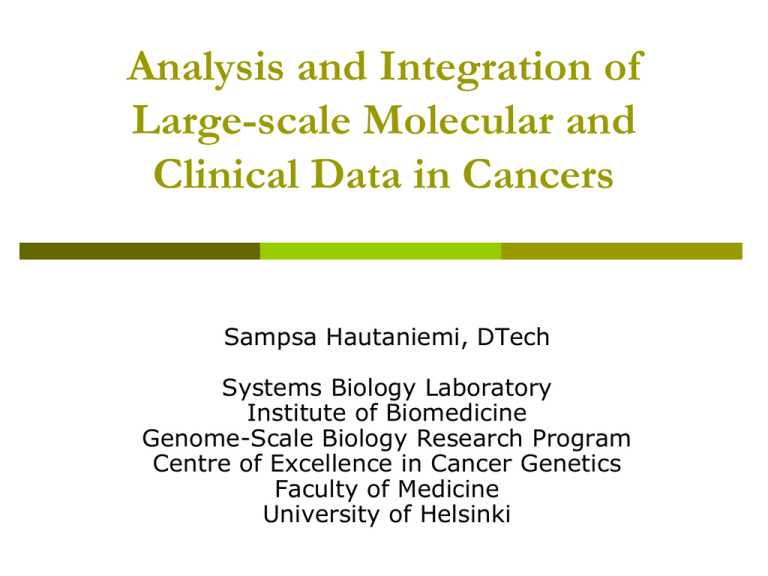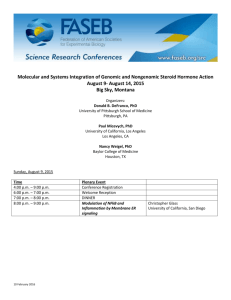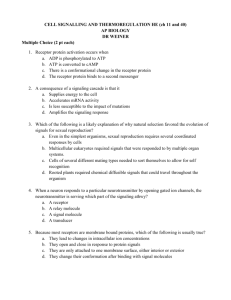Analysis and Integration of Large-scale Molecular and Clinical Data in
advertisement

Analysis and Integration of Large-scale Molecular and Clinical Data in Cancers Sampsa Hautaniemi, DTech Systems Biology Laboratory Institute of Biomedicine Genome-Scale Biology Research Program Centre of Excellence in Cancer Genetics Faculty of Medicine University of Helsinki Table of Contents The essence of systems biology: Iteration and collaboration. The essence of systems biology II: Multilevel data. Iteration in ovarian cancer. Multi-levelity of breast cancer. The essence of systems biology III: Computation. Anduril computational framework & glioblastoma multiforme. Systems Biology: Iteration Adapted from a slide by Peter Sorger Ovarian Cancer Epithelial ovarian cancer is the fifth most frequent cause of female cancer deaths, with an overall 5-year survival rate below 50%. The standard chemotherapy for high-grade serous ovarian cancer (HGS-OvCa) is platinum-taxane combination. Majority of patients suffer relapse <18 months. No clinically applicable methods to predict the prognostic outcome or even to identify the patients unresponsive to current therapies. Aims of the HGS-OvCa Study To identify poor response and good response subtypes of HGS-OvCa. Report biomarkers that allow to identify whether a HGS-OvCa patient responds to the platinum treatment. We developed a computational method that integrates transcriptomics and clinical data in subtype finding step. We used transcriptomics and clinical data from 184 HGS-OvCa patients treated with platinum and taxane from TCGA repository. Three Subtypes of HGS-OvCa Chen et al. In preparation. Validation, validation, validation We also used an independent prospective HGS-OvCa cohort of 29 patients. Data measured with qRT-PCR. Chen et al. In preparation. Pathway Analysis Our pathway analysis (too) identified TR3 as a potential driver for platinum resistance. TR3 Inhibition with Two Drugs We identified two signaling pathway regulators for TR3 and associated inhibitors. The use of two inhibitors should transform the HGS-OvCa cells sensitive to platinum. AKT inh + AKT inh + ERK5 inh Chen et al. In preparation. Systems Biology II: Multi-level Data eAtlas of Pathology While cancer cells are clearly visible the exact molecular causes for are still unknown. Need to study cancer samples at multiple levels. Multiple Levels of Data Genetics Transcriptome Proteomics Epigenetics Clinical 100 samples lead to ~200 million data points. Multiple level data: Estrogen Receptor Nuclear receptor: Estrogen receptor Gene regulation Transcription factor Genomic action Non-genomic action Why Is This Important? Estrogen receptor is the most important clinical variable in determining how to treat a breast cancer patient. There are several anti-cancer drugs targeting estrogen receptor pathway. Currently unknown which tumors do not response to therapy. Finding genes respond to estrogen receptor stimulus may give clues which genes are important in ER inhibition resistance. Hugo Simberg: Garden of Death Data We used chromatin immunoprecipitation combined with massive parallel sequencing (ChIP-seq) to determine genome-wide occupancy (eight time points) after estradiol stimuli in MCF-7 breast cancer cell line: Estrogene receptor a RNA polymerase II Histone marks (H3K4me3, H2A.Z) These experiments resulted in >2.0 billion data points to the initial analysis. SYNERGY database SYNERGY database is available and fully operational. http://csblsynergy.fimm.fi/ Finding ER Responsive Genes Results We identified 777 estrogen receptor early responding genes. Interestingly, the major estrogen receptor related changes in cells were due to nongenomic action. Results Next we searched for genes that have survival association in a breast cancer cohort of 150 ER+/HER2-/postmenopausal patients in The Cancer Genome Atlas (TCGA) cohort. Based on Kaplan-Meier analysis we identified 23 genes with survival p<0.05. The best survival associated gene was ATAD3B. Kaplan-Meier for ATAD3B Intermission Pol2 activity is much better way of searching for responsive genes to a cue that mRNA. In deep sequencing, the sequencing depth is important (with our 200 mill. short-read Pol2 data, we found many ER responsive genes not found in 20 mill. short-read GRO-seq). How to systematically analyze multi-level data? Multi-level Cancer Research Requires Computational Methods Storing the data and computing power are the first (but relatively small) hurdles. Analysis of large-scale, heterogeneous data is much more challenging than single genomics or proteomics data analysis. There is a need for computational infrastructure. Writing an analysis program fast without proper infrastructure will lead to delays and errors in larger projects. Infrastructure: Anduril Anduril is a computational framework to integrate large-scale and heterogeneous data, knowledge in bio-databases and analysis tools. The main design principles are: Modular pipeline analysis approach Scalable Open source, thorough documentation http://www.anduril.org/ Method written in any programming language executable from the command prompt can be included. Produces automatically the result PDF and website containing the results. Complex Pipelines Are Fragile Glioblastoma Multiforme (GBM) Glioblastoma multiforme (GBM) is one of the deadliest cancers. The Cancer Genome Atlas (TCGA) has published data from >500 GBM patients: comparative genomic hybridization arrays single nucleotide polymorphism arrays exon and gene expression arrays microRNA arrays methylation arrays clinical data Which genes or genetic regions have survival effect? GBM Results in Anduril Website Latest on moesin in GBM (Sequence) Component Libraries Over 400 Anduril components already available. Pipelines: ChIP-seq (EMBO J 2011, Cancer Res 2012, ...) RNA-seq (not published) miRNA-seq (not published) DNA methylation-seq (not published) Whole-genome sequence & exome-sequence (not published) Image analysis (manuscript) Summary Characterization of a complex disease first requires identifying the key variables. Multi-level data integration requires computational infrastructure and data-intensive computing. This requires integration data from multiple levels, iterative mode of research and collaboration. We have developed Anduril to organize large-scale data analysis projects (imaging, deep sequencing, database usage, conversions, etc.) The need for computational infrastructure is evident in particular when analyzing deep sequencing data. All our methods are (will be) freely available. http://research.med.helsinki.fi/gsb/hautaniemi/software.html Acknowledgements Systems Biology Lab Funding Academy of Finland Finnish Cancer Organizations Sigrid Jusélius Foundation EU FP7 ERA-NET SysBio+ Biocenter Finland Biocentrum Helsinki Collaborators Olli Carpén Henk Stunnenberg George Reid Jukka Westermarck






![Shark Electrosense: physiology and circuit model []](http://s2.studylib.net/store/data/005306781_1-34d5e86294a52e9275a69716495e2e51-300x300.png)




